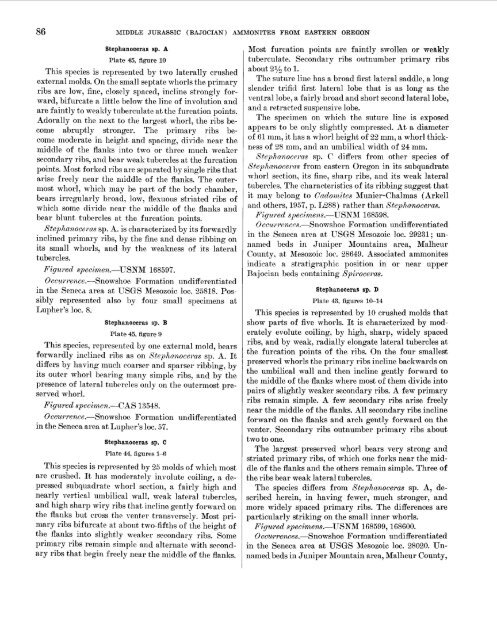Middle Jurassic (Bajocian) Eastern Oregon
Middle Jurassic (Bajocian) Eastern Oregon
Middle Jurassic (Bajocian) Eastern Oregon
You also want an ePaper? Increase the reach of your titles
YUMPU automatically turns print PDFs into web optimized ePapers that Google loves.
86 MIDDLE JURASSIC (BAJOCIAN) AMMONITES FROM EASTERN OREGON<br />
Stephanoceras sp. A<br />
Plate 45, figure 10<br />
This species is represented by two laterally crushed<br />
external molds. On the small septate whorls the primary<br />
ribs are low, fine, closely spaced, incline strongly forward,<br />
bifurcate a little below the line of involution and<br />
are faintly to weakly tubercu]ate at the furcation points.<br />
Adorally on the next to the largest whorl, the ribs become<br />
abruptly stronger. The primary ribs become<br />
moderate in height and spacing, divide near the<br />
middle of the flanks into two or three much weaker<br />
secondary ribs, and bear weak tubercles at the furcation<br />
points. Most forked ribs are separated by single ribs that<br />
arise freely near the middle of the flanks. The outermost<br />
whorl, which may be part of the body chamber,<br />
bears irregularly broad, low, flexuous striated ribs of<br />
which some divide near the 1niddle of the flanks and<br />
bear blunt tubercles at the furcation points.<br />
Stephanoceras sp. A. is characterized by its forwardly<br />
inclined primary ribs, by the fine and dense ribbing on<br />
its sma1l whorls, and by the weakness of its lateral<br />
tubercles.<br />
Figured specimen.-USNM 168597.<br />
Occurrence.-Snowshoe Formation undifferentiated<br />
in the Senec.:t area at USGS Mesozoic loe. 25818. Possibly<br />
represented also by .four small specimens at<br />
Lupher's loe. 8.<br />
Steph.anoceras sp. B<br />
Plate 45, figure 9<br />
This species, represented by one external mold, bears<br />
forwardly inclined ribs as on Stephanoceras sp. A. It<br />
differs by having much coarser and sparser ribbing, by<br />
its outer whorl bearing many simple ribs, and by the<br />
presence of lateral tubercles only on the outermost preserved<br />
whorl.<br />
Figured specimen.--CAS 13548.<br />
Occurrence.-Snowshoe Formation undifferentiated<br />
in the Seneca area at Lupher's loc. 57.<br />
Stephanocer.as sp. C<br />
Plate 44, figures 1-6<br />
This species is represented by 25 molds of which most<br />
are crushed. It has moderately involute coiling, a depressed<br />
subquadrate 'vhorl section, a fairly high and<br />
nearly vertical umbilical wall, weak lateral tubercles,<br />
and high sharp wiry ribs that incline gently forward on<br />
the flanks but cross the venter transversely. Most primary<br />
ribs bifurcate at about two-fifths of the height of<br />
the flanks into slightly weaker secondary ribs. Some<br />
primary ribs remain simple and alternate with secondary<br />
ribs that begin freely near the middle of the flanks.<br />
Most furcation points are faintly swollen or · wettkly<br />
tuberculate. Secondary ribs outnumber primary ribs<br />
about 2=Y2 to 1.<br />
The suture line has a broad first lateral s·addle, a long<br />
slender trifid first lateral lobe that is as long as the<br />
ventral lobe, a fairly broad and short second lateral lobe,<br />
and a retracted suspensive lobe.<br />
The specimen on which the suture line is exposed<br />
appears to be only slightly compressed. At a diameter<br />
of 61 mm, it has a whorl height of 22 mm, a whorl thickness<br />
of 28 mm, and an umbilical width of 24 mm.<br />
Stephanoceras sp. C differs from other species of<br />
Stephanoceras from eastern <strong>Oregon</strong> in its subquadrate<br />
whorl section, its fine, sharp ribs, and its weak lateral<br />
tubercles. The characteristics of its ribbing suggest that<br />
it may belong to Oadomites Munier-Chalmas (Arkeil<br />
and others, 1957, p. L288) rather than Stephanocera8.<br />
Figtrred speci1nens.-USNM 168598.<br />
Ocew'1'ence8.-Snowshoe Formation undifferentiated<br />
in the Seneca area at lTSGS Mesozoic loc. 29231; unnamed<br />
beds in Juniper Mountains area, Malheur<br />
County, at Mesozoic loc. 28649. Associated ammonites<br />
indicate a stratigraphic. position in or near upper<br />
<strong>Bajocian</strong> beds containing Spiroceras.<br />
Stephanoceras sp. D<br />
Plate 43, figures 10-14<br />
This species is represented by 10 crushed molds that<br />
show parts of five whorls. It is characterized by moderately<br />
evolute coiling, by high, sharp, widely spaced<br />
ribs, and by weak, radially elongate lateral tubercles at<br />
the furcation points of the ribs. On the four smallest<br />
preserved whorls the primary ribs incline backwards on<br />
the umbilical wall and then incline gently forward to<br />
the middle of the flanks where most of them divide into<br />
pairs of slightly weaker secondary ribs. A few primary<br />
ribs remain simple. A few secondary ribs arise freely<br />
near the middle of the flanks. All secondary ribs incline<br />
forward on the flanks and arch gently forward on the<br />
venter. Secondary ribs outnumber primary ribs about<br />
two toone.<br />
The largest· preserved whorl bears very strong and<br />
striated primary ribs, of which one forks near the middle<br />
of the flanks and the others remain simple. Three of<br />
the ribs bear weak lateral tubercles.<br />
The species differs from Stephanoceras sp. A, described<br />
herein, in having fewer, much stronger, and<br />
more widely spaced primary ribs. The differences are<br />
particularly striking on the small inner whorls.<br />
Fig1.tred specimens.-USNM 168599, 168600.<br />
Occurrences.-Snowshoe Formation undifferentiated<br />
in the Seneca area at USGS Mesozoic loc. 28020. Unnamed<br />
beds in Juniper Mountain area, Malheur County,

















